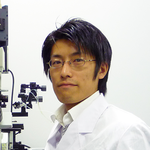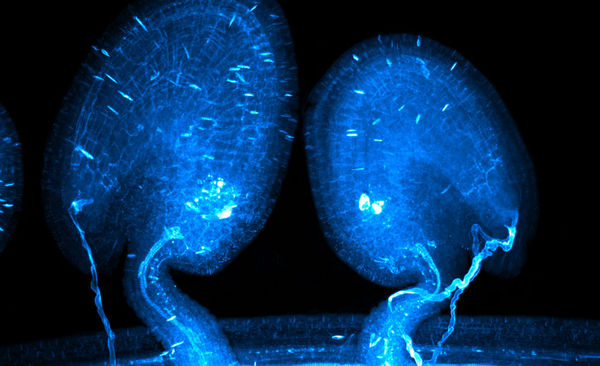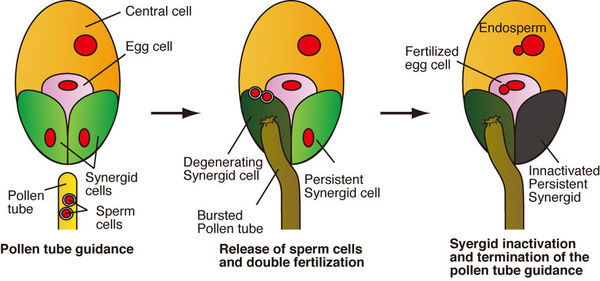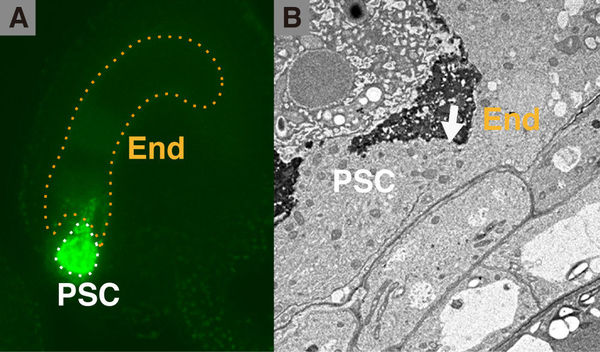Features
Features
Novel cell fusion terminates female courtship in plant
- ツイート
- 2017/06/23
Institute for Transformative Bio-Molecules / IAR
Designated Assistant Prof. of Young Leaders Cultivation Program, Daisuke Maruyama
Source: IAR Letter, vol.14, March 2016
*about IAR: Nagoya University's Institute for Advanced Research was established to produce internationally recognized academic research of the highest caliber, and to contribute to society through the research achievements at the Institute.
Two developing seeds receiving single (left) or double (right) pollen tube(s) in Arabidopsis thaliana
In flowering plants, immotile sperm cells are kept inside a growing pollen tube and conveyed to an egg-containing structure known as an ovule. The fertilized ovule terminates the attraction to prevent additional fertilization by another pair of sperm cells from the second pollen tube. In this study, we discovered a cessation mechanism of the pollen tube attraction caused by novel cell-to-cell fusion in a plant. (1)
INTRODUCTION
In sexually reproducing organisms, a one-to-one relationship is formed between male and female cells (e.g., an egg and a sperm). In flowering plants, including the model plant used in this study, Arabidopsis thaliana, this pairing is established during pollen tube guidance. The pollen tube precisely targets an ovule due to the secretion of attractant peptides from two synergid cells, which are accessory cells adjacent to the egg cell. In the final stage of the guidance, the pollen tube discharges two sperm cells into a degenerating synergid cell, and each sperm cell fertilizes the egg cell and the central cell, creating the embryo and the endosperm, respectively. After the double fertilization, the ovule ceases to attract an additional pollen tube due to the inactivation of the remaining "persistent synergid cell" (see Figure 1). The prevention of the attraction of multiple pollen tubes is considered to play an important role in efficient male-female pairing in terms of the pollination of fewer pollen grains or the blockade of multiple fertilizations of the egg cell by more than two sperm cells. However, the inactivation mechanisms of the persistent synergid cell had previously been totally unknown.
Figure 1. Double fertilization and persistent synergid inactivation. Schematic drawing of an ovule attracting a single pollen tube (left), the ovule receiving two sperm cells from the pollen tube (middle), and inactivation of the persistent synergid after double fertilization (right).
Discovery of SE fusion
To elucidate the alteration of the persistent synergid cell, we performed time-lapse imagings of fertilized ovules from a transgenic plant expressing mitochondrion-localized Green Fluorescent Protein (GFP) under the control of a synergid-specific gene promoter. To our surprise, the GFP-labeled mitochondria began to migrate from the persistent synergid cell to the endosperm within a few hours after the double fertilization, indicating an efflux of mitochondria to the endosperm (Figure 2A) . We thus assumed the existence of tiny "holes" between the persistent synergid cell and the endosperm. Electron micrographs of fertilized ovules revealed the absence of a cell wall separating the two cells (Figure 2B) . These data strikingly show novel cell-to-cell fusion in flowering plants. It is well known that plant cells are usually surrounded by a thick cell wall. Therefore, this finding that we termed "synergid-endosperm fusion (SE fusion)" was surprising to many plant researchers. There are only two cell-fusion events identified in the normal developmental process in flowering plants: one is fertilization of the egg cell, and the other is fertilization of the central cell. The SE fusion is the third cell-to-cell fusion identified after 117 years since the discovery of double fertilization.
Figure 2. Synergid-endosperm fusion (SE fusion). (A) Migration of mitochondria (green) from the persistent synergid (white dotted line) to the endosperm (orange dotted line). (B) Electron micrograph of fusion site (arrow). "End" and "PSC" are abbreviations of endosperm and persistent synergid cell, respectively.
Roles of SE fusion
The identity of the persistent synergid cell must be drastically changed by the SE fusion, because the persistent synergid cell is diluted many fold by the efflux of a large volume of cellular contents to the endosperm. Time-lapse imagings of a transgenic plant visualizing AtLURE1, a pollen tube attractant peptide in Arabidopsis,(2) revealed that premature AtLURE1 accumulated in the persistent synergid cell exhibited a rapid decrease through SE fusion. Indeed, the ovules with the AtLURE1 signal also decreased in the early stages of the seed development in an immuno-staining experiment. Presumably, the cytoplasmic dilution in the persistent synergid cell would reduce AtLURE1 secretion and disrupt the gradient of mature AtLURE1 on the surface of the fertilized ovule, leading to rapid termination of further pollen tube attraction.
The SE fusion appears to result in disorganization of the persistent synergid nucleus, one of characteristic features of an inactivating synergid cell. Time-lapse imagings of nuclei in the entire ovule showed that the nuclear disorganization occurred by two to six hours after fertilization. Interestingly, dynamic chromosomal condensations of the nuclear disorganization were observed during the mitotic stage of the endosperm. Although the endosperm nucleus (or nuclei) gradually accumulated a mitotic-phase marker Cyclin B1;2-YFP, the persistent synergid nucleus exhibited abrupt accumulation of the marker, probably due to the influx of the endosperm contents caused by the SE fusion. These data indicate that the persistent synergid nucleus begins to share the same cytosol with the endosperm prior to preparation for mitosis (e.g., DNA synthesis), and is selectively eliminated by a failure of chromosome segregation known as a mitotic catastrophe.(3)
Model of synergid inactivation
Our previous data demonstrated independent roles of the egg cell and the central cell in the cessation of pollen tube attraction.(4) Thus, we examined whether SE fusion was one such mechanism. Single fertilization of either the egg cell or the central cell was induced by pollination of a mutant exhibiting reduced fertility, and the frequency of the SE fusion by an endosperm marker plant was analyzed. The SE fusion was never observed in the ovules after single fertilization of the egg cell, while the fusion took place in the ovules after the single fertilization of the central cell, suggesting the cessation of pollen tube attraction controlled by the central cell via the SE fusion. So, how does the egg cell in turn regulate the synergid inactivation? We focused on the signaling pathway of a gaseous hormone, ethylene, because the signaling activated after double fertilization is responsible for the nuclear disorganization of the persistent synergid.(5) Mutant-induced single fertilization analysis demonstrated that the egg cell, but not the central cell, predominantly stabilized EIN3, a key transcription factor in the ethylene signaling. Taken together, we proposed that a three-step synergid inactivation regulates two independent fertilizations. First, fertilization of the egg cell predominantly induces the activation of ethylene signaling and prepares nuclear disorganization of the persistent synergid. Second, fertilization of the central cell triggers the SE fusion, and the synergid contents including pre-secreted AtLURE1 are diluted, leading to acute disruption of the pollen tube guidance. Finally, the identity of the synergid cell completely disappears due to the nuclear disorganization of the persistent synergid during endosperm proliferation.
CONCLUTION
We successfully elucidated the inactivation mechanisms of the persistent synergid cell by a series of live-imagings and mutant analyses. The regulation of the second pollen tube attraction plays an important role in plant fertility, and understanding of the mechanism may contribute to the development of novel breeding techniques. The SE fusion process suggests novel types of programmed-cell-death mediated by cell-to-cell fusion, and has had a strong impact on basic cell biology as well as plant research. In the process of exploring the molecular mechanisms of SE fusion, we will learn more about the physiological functions of cell-to-cell fusion in various developmental scenes, which have been overlooked for years in botany.
ACKNOWLEDGEMENTS
I would like to thank Prof. Higashiyama and the lab members for giving me advice and continuous encouragement. I also highly appreciate the other co-authors: Völz, R.; Takeuchi, H.; Kawashima, T.; Mori, T.; Groß-Hardt, R.; Nishikawa, S.; Ito, M.; Igawa, T.; Umeda, M.; Kurihara, D.; and Ueda, M.
REFERENCES
(1) Maruyama, D. et al., "Rapid elimination of the persistent synergid through a cell fusion mechanism" Cell 161, 907–918 (2015).
(2) Takeuchi, H. and Higashiyama, T., "A species-specific cluster of defensin-like genes encodes diffusible pollen tube attractants in Arabidopsis" PLoS Biol. 10, e1001449.
(3) Maruyama, D. et al., "Selective nuclear elimination in multinucleate cells" Oncotarget 6, 30447–30448 (2015).
(4) Maruyama, D. et al., "Independent control by each female gamete prevents the attraction of multiple pollen tubes" Dev. Cell 25, 317–323 (2013).
(5) Völz, R. et al., "Ethylene signaling is required for synergid degeneration and the establishment of a pollen tube block" Dev.Cell 25, 310–316 (2013)
 Daisuke Maruyama: Designated Assistant Professor of Young Leaders Cultivation Program, Institute for Transformative Bio-Molecules / Institute of Advanced Research, Nagoya University(~March, 2016)
Daisuke Maruyama: Designated Assistant Professor of Young Leaders Cultivation Program, Institute for Transformative Bio-Molecules / Institute of Advanced Research, Nagoya University(~March, 2016)
*April, 2016~、Assistant Professor, Kihara Institute for Biological Research (KIBR), Yokohama City University
Related links
- download IAR_letter_Maruyama.pdf
- "Cell fusion 'eats up' the 'attractive cell' in flowering plants" ,Research Highlights, ITbM, 2015/04/24
- "Exploring the entire story of plant fertilization using live imaging" ,Highlights, NU Research, 2015/10/21
NU Research
(English)




